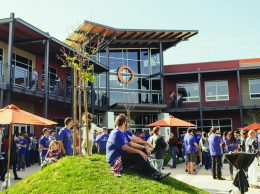Farmers look to tech to keep county’s ag competitive
The times are changing for farmers in Ventura County.
Heavy government regulations, environmental restraints and competition from south of the border have led farmers in the county’s $2 billion agricultural industry to change the way they operate. Like their counterparts across the state, growers in Ventura County are increasingly reliant on technology to speed up the harvesting process and ensure food and worker safety.
“Farming is typically thought of as an old-school operation, but technology plays a bigger and bigger role every day,” Scott Deardorff, co-owner of Deardorff Family Farms, said at an ACG 101 conference on March 7.
The conference was moderated by Griff Barkley, who owns Barkley Insurance and Risk Management, a firm that specializes in helping companies in the agriculture industry manage costs and risks. Barkley said limited water and energy and a growing worldwide demand for food have spurred research and innovation in the farming business. Technology, he said, is increasingly important to farmers’ bottom lines.
Rob Roy, president and general counsel of Ventura County Agricultural Association, said the cost of complying with regulations for a small business is about $14,000 per year. Farmers have banded together through associations like Roy’s to make sure they’re meeting the regulations, but they still have to find ways to cut costs in other areas to pay for it.
Jerry Pogorzelski is the chief financial officer for Saticoy Lemon Association, a cooperative that markets the fruit of its 260 members through Sunkist Growers. Saticoy and Sunkist have developed a few new technologies over the last five years that he said have raised growers’ profits.
Saticoy provides Sunkist with one-third of its lemon supply each year. Lemons are different from most ag products because they can last up to three months in storage, Pogozelski said. Because of the amount of time the fruit spends in storage, an essential part of the lemon business is keeping track of how close each piece is to rotting and how soon they need to be shipped out.
The co-op has created special software that keeps track of its inventory, Pogorzelski said, which allows it to forecast when they need to ship the fruit. That’s a huge improvement over manually inspecting each lemon because it cuts down on labor and storage costs. The technology also improves the quality of each lemon. Five years ago, workers took random samples of lemons to check if they were rotten. Now they’re able to individually check each piece, which means every lemon Saticoy ships is a good one.
“The bottom line is that we expect growers’ returns to improve 10 percent or more,” Pogorzelski said.
Deardorff and San Miguel Produce Vice President Jan Berk both said technology is essential to keep up with changing regulations and still turn a profit.
“There are a lot of reasons technology plays a bigger role every year. Primarily it’s the reduced costs,” said Berk, whose Oxnard-based company mainly grows leafy greens. “Growing vegetables in California gets more expensive every year, and we’re constantly hit with food safety and water regulations. We have to constantly stay on the cutting edge of tech to survive.”
One way San Miguel Produce does that is by using its own high-tech water treatment plant. The plant was originally installed to meet Ventura County’s strict water regulations, but Berk said her company wants to take it to the next level and use the water to irrigate its crops. That would help keep costs down and meet regulations at the same time, she said.
At Deardorff Family Farms in Oxnard, the owners are concentrating on using technology to meet food safety regulations. Barkley, the moderator, said at the conference that California is the most regulated state in the country, and it’s getting more difficult to do business every year.
Deardorff is tackling regulatory red tape by using GPS equipment to track what was planted where in their fields at what time. Deardorff said the system makes the farm measurably more efficient by saving fuel, labor, wear and tear on equipment. It also helps ensure food safety by keeping close track of produce quality and worker safety by reducing employees’ workloads.
The farm is also constructing a new 100,000 square-foot processing and packing building that will meet all environmental regulations.
“The new facility opens the door to saving energy and water, and regulations in those areas are driving ag right now,” Deardorff said.










